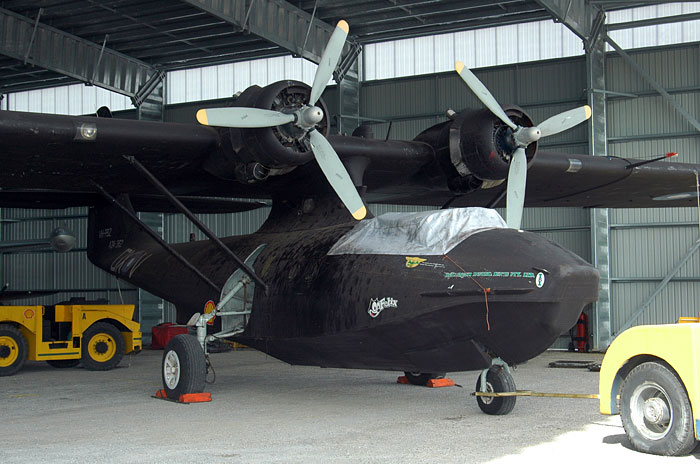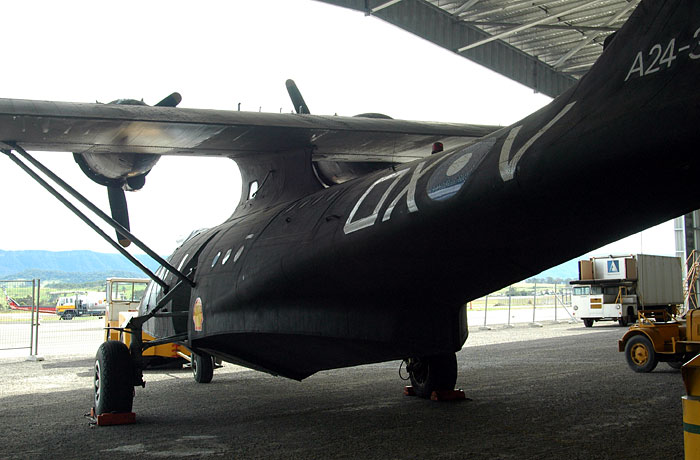|
PBY-6A Catalina
at
HARS' hangar, Albion
Park, Australia
|
 |
|
Consolidated
PBY-6A Catalina |
images by Brett Green
text by HARS

HyperScale is
proudly supported by Squadron.com
You can
visit the HARS website for
more information about the Society,
its aircraft, its restorations and operations
The Historical Aircraft Restoration
Society
The Historical Aircraft Restoration Society (HARS) was formed in
1979 by a group of aviation enthusiasts interested in the
preservation of Australian Aviation History. Their mission is "To
recover and where possible restore to flying condition, aircraft or
types of aircraft that have played a significant part in Australian
Aviation History both in the Civil and Military arenas".
HARS has restored a large number of aircraft from the small,
including a Cessna C-180 and a DeHavilland Tiger Moth, right through
to the pride a Lockheed Super Constellation.

In November 2002, the Society relocated its operations to The
Illawarra Regional Airport, Albion Park Rail. In recent years,
significant growth in aircraft acquisitions has required the Society
to seek a more permanent facility capable of expansion. HARS' new
home at the Illawarra Regional Airport will allow the Society to
establish a world class Flying Museum.
HARS' PBY-6A Catalina
The Catalina operated and maintained by the Historical Aircraft
Restoration Society, was purchased in 2002 in Portugal where it had
been operated as a water bomber under Chilean registration, and was
flown to Australia in September 2003.
The aircraft is a PBY-6A model, built in 1945 by Consolidated at its
New Orleans plant, c/n 2043 and delivered to the US Navy. It was
later sold as surplus to the Aircraft Instrument Corporation and
placed on the US Civil Register as N9562C. It was later transferred
to Chile and flew with several companies until placed in storage in
1960 for twenty years. It was retrieved from storage and began
operations as a water bomber with registration CC-CCS. Whilst in
service fire fighting the aircraft sank in Lago Guitierrez,
Argentina on the 27th of January, 1986. It was salvaged, rebuilt and
back in service in 1988. In 1991 it was ferried across the Atlantic
for operation by the Spanish land management department ICONA.
Subsequently it went on charter to Aerocondor in Portugal.
HARS intends to restore the Catalina to conform as closely as
possible to the configuration of the famous RAAF "Black cats" of
World War II. The RAAF "Black Cats" were pure flying boats, enabling
long range and maximum possible loads with extended water take offs.
The Society's PBY-6A ia an amphibian (with retractable wheels) for
taxiing to our workshop, the only practical way to maintain the
aircraft, but once fully restored, in flight with wheels retracted,
it will resemble the original "Black Cats" very closely.

The incredible versatility of the Catalina was demonstrated most
during World War II. The Society's exhibit will proudly represent
the "Black Cat" squadrons of the RAAF and will be a fitting tribute
to the 239 Australian airmen who lost their lives undertaking
hazardous bombing and mine laying missions both at night and in
daylight, and always at very low altitudes. These activities caused
significant disruptions to the Japanese supply lines particularly
with oil and essential military cargoes by the destruction of their
shipping. Because of their long range capability they proved to be
excellent reconnaissance aircraft. Their most notable activity in
this capacity was in the shadowing of the Japanese Naval Force just
prior to the Coral Sea Battle. In all, The RAAF had a total of 166
Catalina aircraft.
Even after the outbreak of war, Qantas took delivery of nineteen
Catalinas between January and October 1941. They were to convey
important persons as passengers traveling overseas. Their most
notable route was the 'Double Sunrise Service' direct from Perth to
Ceylon. it was the only form of personnel transport between
Australia, Europe and America during the war.
Catalinas continued in passenger service after the war linking many
of the Pacific islands with Australia. The last Qantas flying boat
service was a Catalina New Guinea flight on July 24th, 1958 using
VH-EBD. New Guinea services were then taken over by TAA using two
amphibian PBY-5As acquired from Canada. The undercarriage and
hydraulics were removed to increase payload.
Several other airlines, including Ansett, employed Catalinas in the
1950's and 1960's for brief periods on island work. It was
disappointing that none were preserved in flying condition and that
an airworthy example has had to be purchased overseas at a great
expense.
Click the thumbnails below
to view larger images:
Images Copyright © 2005 by
Brett Green
Text Copyright © 2005
by HARS
Page Created 03 May, 2005
Last updated
02 May 2005
Back to HyperScale Main
Page
Back to Features
Page
|
Home |
What's New |
Features |
Gallery |
Reviews |
Reference |
Forum |
Search